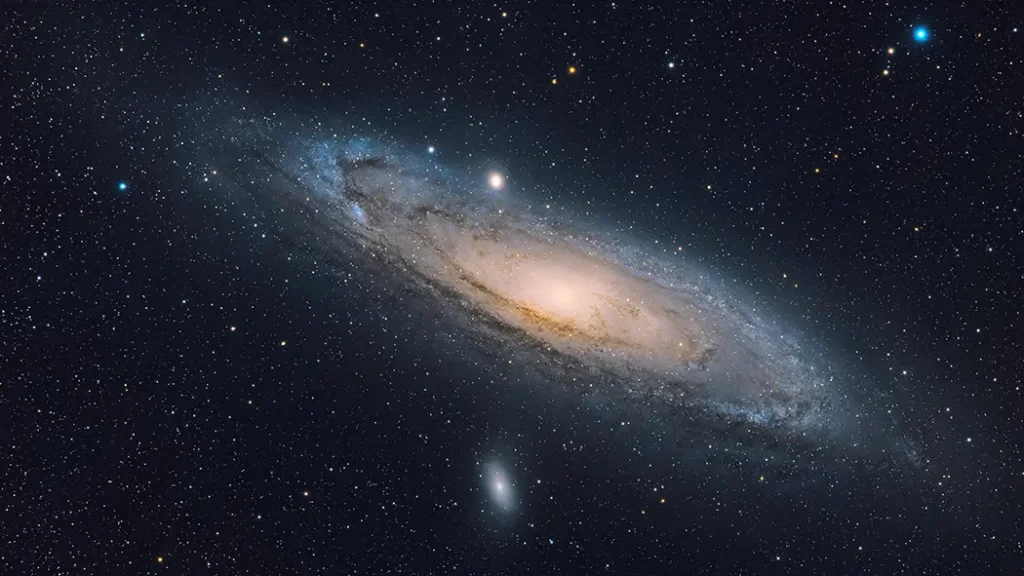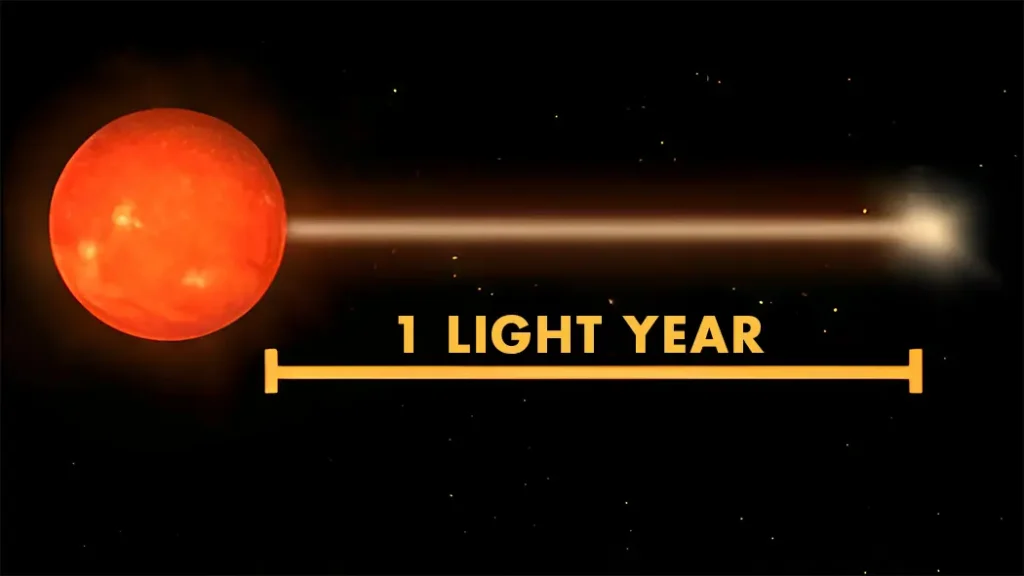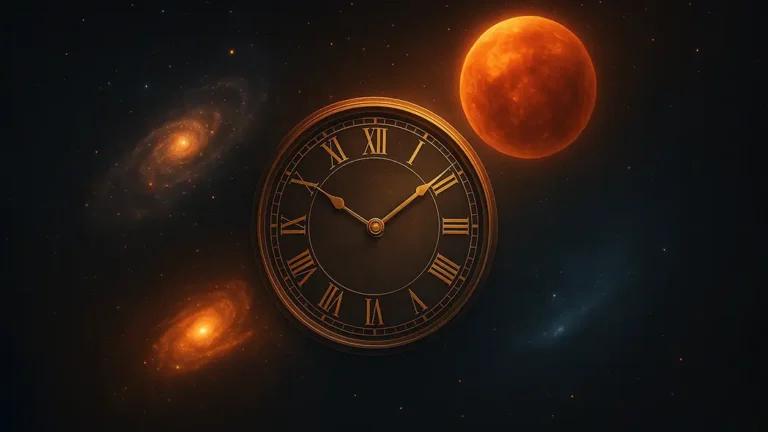When you look up at the night sky, you might see stars, planets, and sometimes even a cloudy patch of light. That faint patch is not a star. It is not a cloud either. It is a galaxy. This galaxy is called Andromeda.
Andromeda is the closest big galaxy to us. It is the closest one that is like our own galaxy, the Milky Way. But even though it is the “closest,” it is still very far away.
So, how far away is the Andromeda galaxy? Let’s explore the answer in a simple way.
What Is a Galaxy?
Before we talk about distance, let us first understand what a galaxy is.
A galaxy is a huge group of stars, gas, dust, and dark matter. All of this is held together by gravity. Our Sun is one of many stars in the Milky Way galaxy. Andromeda is another galaxy, full of stars like our Sun.
What is the Andromeda Galaxy?
Galaxies come in many shapes and sizes. Some are small. Some are big. Some look like spirals. Some look like blobs.
The Andromeda Galaxy is a large spiral galaxy. It is shaped like a flat disc with arms that curve around the center. Our galaxy, the Milky Way, has a similar shape.

Andromeda is the closest large galaxy to the Milky Way. It is also the largest galaxy in our local group of galaxies. The local group is a small cluster of more than 50 galaxies that are near each other in space.
The Andromeda Galaxy has about one trillion stars. That’s more than twice the number of stars in the Milky Way. It also has many solar systems, gas clouds, dust, and dark matter.
How Do We Measure Distance in Space?
Distances in space are huge. We cannot use kilometers or miles like we do on Earth. The numbers would be too big to understand. So, scientists use light-years.
A light-year is the distance that light travels in one year. Light moves very fast. It travels about 9.46 trillion kilometers (about 5.87 trillion miles) in just one year. That is 9,460,000,000,000 kilometers!

So, when we say something is one light-year away, we mean it takes light one whole year to get to us from that place.
How Far Away Is the Andromeda Galaxy?
The Andromeda galaxy is about 2.5 million light-years away from us.
Let’s say that again: two and a half million light-years.
This means that the light we see from Andromeda tonight started its journey 2.5 million years ago. Back then, early humans were just starting to appear on Earth.
So, when we look at Andromeda galaxy, we are looking into the past. We are seeing the galaxy as it was millions of years ago.
How Did Scientists Measure the Distance to the Andromeda galaxy?
You might wonder how scientists know how far Andromeda galaxy is. After all, we cannot stretch a measuring tape through space.
Scientists use a few clever ways to measure distance. Two of the most helpful methods are:
1. Special Stars That Blink (Cepheid Variable)
One way is to look at special types of stars called Cepheid variables. These stars don’t shine steadily. They blink in a regular pattern, like a heartbeat. The way they blink tells scientists exactly how bright they really are. Then, scientists look at how bright they seem from Earth. If the star looks dimmer than it should, that means it must be very far away. This helps them figure out the star’s distance.
It is like seeing a streetlight in the fog. If the light looks dim but you know it is usually bright, then it must be far away—not broken.
2. Big Star Explosions (Supernovae)
Another method is to look at giant star explosions called supernovae. These are powerful explosions of light and energy. Supernovae are very bright and scientists know exactly how bright they should be. By seeing how bright or dim a supernova looks from Earth, they can figure out the distance—just like with the blinking stars.
By using these tools, scientists figured out that Andromeda is about 2.5 million light-years away.
Why Does the Distance to Andromeda Matter?
Knowing how far Andromeda galaxy is can help us learn more about our universe.
- It shows how big space is. Even the “closest” galaxy is millions of light-years away.
- It helps us understand galaxies. If we know how far something is, we can also know how big and bright it really is.
- It helps with future plans. Andromeda and the Milky Way are moving toward each other. One day, they will crash and form a new galaxy. Knowing the distance helps us guess when this will happen.
Will Andromeda galaxy Hit Us?
Yes—but don’t worry.
The Andromeda galaxy is moving toward the Milky Way at about 110 kilometers per second. That may sound fast, but in space terms, it’s normal.
In about 4 billion years, Andromeda and the Milky Way will collide. But this will not be like a car crash. Galaxies are full of empty space. So, most stars will not hit each other. Instead, the galaxies will mix and form a new, larger galaxy.
Some scientists call the new galaxy Milkomeda or Milkdromeda.
Can We See Andromeda galaxy from Earth?
Yes, we can! And you do not need a telescope.
If the sky is dark and there are no clouds or city lights, you might see Andromeda with just your eyes. It looks like a small fuzzy patch of light.
To find it, look for the Andromeda constellation during the fall, if you are in the Northern Hemisphere. In the Southern Hemisphere, it is much harder to see.

When you see it, remember: you are looking at millions of stars, many with their own planets. You are looking millions of light-years away. And you are looking millions of years into the past.
Simple Facts About the Andromeda Galaxy
Here are some simple and fun facts about the Andromeda galaxy:
- It has about 1 trillion stars. That is more than our Milky Way.
- It is about 220,000 light-years wide.
- It has many smaller galaxies around it, like satellites.
- It’s coming toward us at around 110 kilometers per second.
What Makes Andromeda galaxy Special?
Andromeda is special for many reasons:
- It is the closest big galaxy to us.
- It is the largest galaxy in our local group of galaxies.
- It is the only galaxy you can see with the naked eye from Earth (outside the Milky Way).
- It’s on a path to one day merge with our galaxy.
This galaxy gives us a chance to study something that looks very much like our own Milky Way, but from the outside.
How Does This Change How We See the Sky?
When we look at Andromeda, we realize how tiny we are. Earth is just one planet. Our Sun is just one star. The Milky Way is just one galaxy. And Andromeda is just one neighbor in a sea of galaxies.
There are billions of galaxies in the universe. Each one has billions of stars. Each star may have planets. Some of those planets may have life.
The distance to the Andromeda galaxy is just the beginning. There is so much more out there, farther and farther away.
Final Thoughts
So, how far away is the Andromeda galaxy? About 2.5 million light-years. That number is hard to picture. But it tells us something amazing.
It tells us that the universe is vast. It tells us that light can travel for millions of years. It tells us that when we look at the sky, we are also looking at history.
And it reminds us that we are part of something very, very big.




